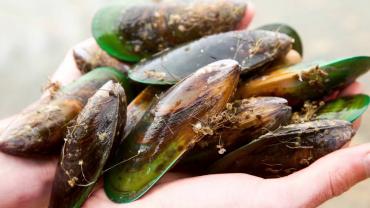
It’s no secret that as a general category seafood is a nutritional powerhouse. Whether it’s the long-chain polyunsaturated fatty acids in salmon and other cold water fish or the off-the-charts B vitamins and minerals in bivalves and crustaceans there’s a reason marine foods are an important part of human diets all over the world. And there’s one bivalve in particular that has special properties when it comes to bone and join health: green lipped mussel.
Green lipped mussels (Perna canaliculus) are native to New Zealand (they’re also called New Zealand mussels) and are one of the largest mussel species with the largest specimens as long as 9 inches! They look just like they sound: the shells are brown with a ring of striking bright emerald green along the lip. The Maori people—a native New Zealand aboriginal tribe—ate raw green lipped mussels as a regular part of their diet. As nutrition research pioneer Weston A. Price DDS detailed in his now classic tome Nutrition and Physical Degeneration the Maori people were healthy robust and physically formidable. Perhaps green lipped mussels were one of their secrets.
Like other mussels the green lipped variety are a good source of protein marine fats and micronutrients. Beyond that they have shown potential benefit for various arthralgias and may have positive synergies with common medications for these ailments. A British arthritis research organization gives green lipped mussel a “green light” for safety and an effectiveness rating of 3/5 for osteoarthritis but only 1/5 for rheumatoid arthritis. The safety classification is especially noteworthy because one of the benefits of giving green lipped mussel (GLM) along with drugs—NSAIDs in particular—is that the b from the damage that often results from NSAID use.
The primary mechanism behind GLM’s efficacy for osteoarthritis is inhibition of COX-1 and COX-2 activity with the effects greater than those from fish oil. Additionally GLM contains glucosamine and chondroitin sulfate which are well regarded for supporting joint health. GLM also inhibits activity of 5-lipoxygenase and its general anti-inflammatory effects were observed at concentrations two orders of magnitude lower than that of fish oil rich in EPA. This led researchers to speculate that a separate component of GLM—a different fatty acid—is primarily responsible for the impressive potency. They found that GLM is a rich source of furan fatty acids (F-acids)—a fatty acid whose concentration is usually low but is higher in aquatic plants and organisms. (It was first identified in a species of northern pike in 1977.) Furan fatty acids seem to be especially potent antioxidants which when combined with the other bioactive compounds in GLM may help explain why GLM is so effective for joint pain and inflammation. It seems other marine species higher up on the food chain lack the enzymes to synthesize F-acids so their content of these compounds may be “dependent on either the consumption of the real producer such as algae or the production by intestinal bacteria.” Moreover there may be something unique to the marine flora of the New Zealand coastline that allows for a greater concentration of F-acids among certain organisms feeding there.
Commercial preparations of GLM extracts have shown anti-inflammatory benefits at doses lower than those of NSAIDs and fish oils. When administered orally to rats they have been shown to protect against adjuvant-induced polyarthritis and collagen(II)-induced auto-allergic arthritis.
Most clinically relevant studies looked at GLM as an adjunct to other treatments not as a replacement therapy. Nevertheless the preponderance of reliable evidence suggests that GLM extract is more effective than placebo particularly for osteoarthritis. Additionally no serious adverse events or side-effects from GLM have been noted in humans or animals. Minor and transient effects (such as stiffness flatulence nausea and gastric discomfort) could have been caused by concomitant NSAID use.